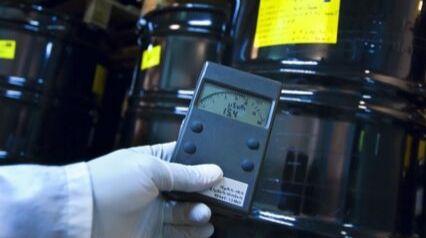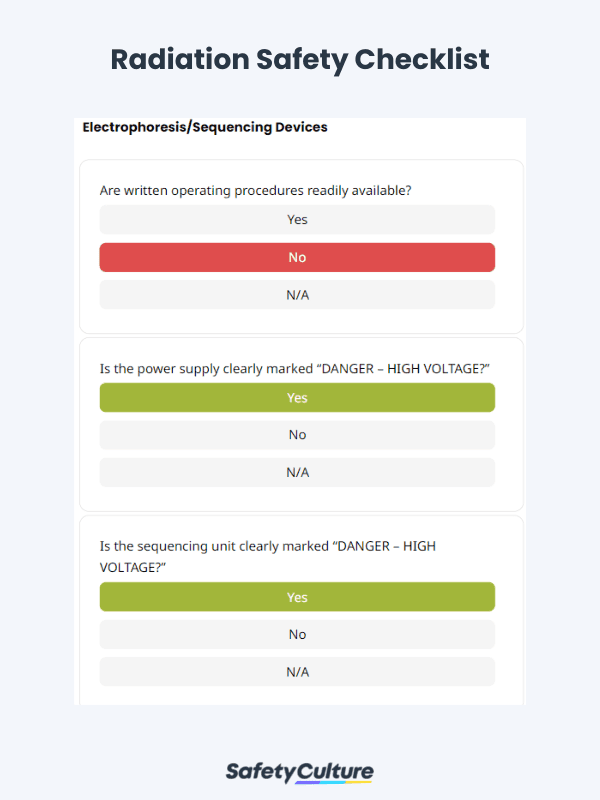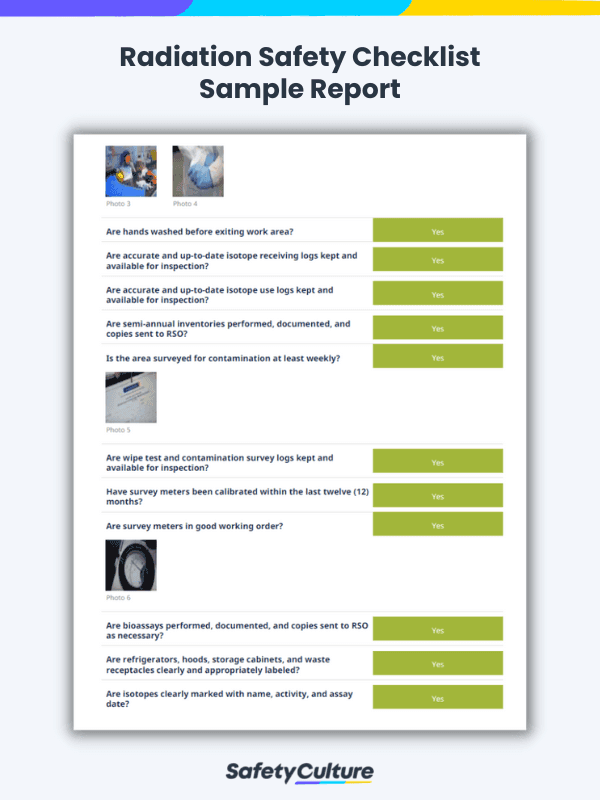What is a Radiation Safety Checklist?
Also called a radiation protection checklist, a radiation safety checklist is a tool used for identifying radiation overexposure hazards and inspecting equipment and Personal Protective Equipment (PPE). This type of checklist is vital for confirming an organization’s conformance with the principles of radiation safety and compliance with regulations on protecting workers against radiation overexposure.
Why is it Critical to Ensure Radiation Safety Using Checklists?
The use of radiation protection checklists by radiation safety officers during regular self-inspections not only can help promote the safety of employees working with equipment that emits radiation or those who handle radioactive material, but also can help the organization prepare for annual compliance audits.
What to Include in a Radiation Safety Checklist
- Title Page – Briefly discuss basic details about the inspection.
- General Information – List information about the site or area where the radiation safety inspection is conducted.
- Warnings and Signs – Check the availability and accessibility of the organization’s posters, warning signs, and materials.
- Radioisotope Safety – Answer questions about work area safety, PPE inspection, isotope use logs, semi-annual inventories, and contamination survey logs, among others.
- Electrophoresis/Sequencing Devices – Inspect the availability of written operating procedures, safety signs, guarded power and electrical contacts, and other unit safety measures.
- Radiation Producing Devices – Ensure that safety tests are performed and documented, annual inspections are conducted, and emergency procedures are posted.
- Recommendations – List recommendations, remarks, and next steps.
- Completion – Provide a space for the inspector to sign off the inspection.
How to Use One
To guide you through using the radiation safety checklist better, you may follow this step-by-step process in accomplishing it:
- Fill in the Title Page with basic information about the inspection or site check you’re conducting. Include the client or site name along with the name of the facilitator.
- Use the General Information section to record details of the building, area supervisor, department, room number, and area use.
- Answer questions in the Warnings and Signs section about the organization’s availability and accessibility of posters, warning signs, and safety materials during the inspection.
- Inspect work area safety and PPE as well as check isotope use logs, semi-annual inventories, and contamination survey logs, among others by answering the guide questions in the Radioisotope Safety section.
- Use the Electrophoresis/Sequencing Devices section to inspect whether written operating procedures are available, safety signs are present, power and electrical contacts are guarded, and other unit safety measures are evident.
- Utilize the Radiation Producing Devices section to answer questions as you check if safety checks and inspections are conducted.
- Fill in the Recommendations field with any recommendations, remarks, and next steps for future reference.
- Complete the checklist and finalize the report by putting your full name and signature as the inspector.
FAQs About Radiation Safety
ALARA, or “as low as reasonably achievable,” is the guiding principle of radiation safety. According to the Centers for Disease Control and Prevention (CDC), one who’s exposed to radiation must use three basic protective measures to effectively practice ALARA. These are time, distance, and shielding.
Commonly, organizations must have a dedicated Radiation Protection Supervisor (RPS). The RPS is responsible for helping the organization ensure its working environment is compliant with safety regulations. While this is the case, the legal responsibility still is the employer’s jurisdiction.
The health effects of radiation exposure are typically categorized into two: threshold effects and non-threshold effects. The former occurs after a higher level of radiation exposure, while the latter can happen at lower levels. Some of the most common harmful effects of radiation impact the following human body parts:
- Hair
- Heart and Brain
- Thyroid
- Blood System
- Reproductive Tract



